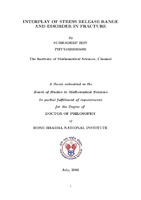- DSpace Home
- →
- IMSc Theses/ Dissertations
- →
- IMSc Theses/ Dissertations
- →
- View Item
JavaScript is disabled for your browser. Some features of this site may not work without it.
| dc.contributor.author | Subhadeep Roy | |
| dc.date.accessioned | 2016-10-14T06:35:24Z | |
| dc.date.available | 2016-10-14T06:35:24Z | |
| dc.date.issued | 2016 | |
| dc.date.submitted | 2016 | |
| dc.identifier.uri | https://dspace.imsc.res.in/xmlui/handle/123456789/389 | |
| dc.description.abstract | Fracture is basically the study of a disordered system which is way out of equilibrium. In real systems, microscopically, the fracture process is guided by the behavior of defects (like micro-cracks, dislocation, grain boundary etc.).Mainly it depends on two major factors : (I) How venerable the defects are ? (II) Whether these defects interacts with each other or not ? In statistical mechanics, disorder systems and systems out of equilibrium are extensively studied in the last decade. So it will be interesting to study fracture in statistical mechanical point of view. We have implemented the above two factors that guides failure process in a statistical model, namely Fiber Bundle Model (and some part in Spring Ladder Model) and studied their effect on the failure process. (1) Effect of Disorder: In mean field limit the fiber bundle model is studied with varying disorder. We find a critical disorder (δc) value below which the model breaks abruptly like brittle material and above this disorder we get quasi-brittle like non linear response. At δc, the relaxation time diverges and the avalanche size distribution shows self organized behavior. δc is like the “Brittle to quasi-brittle transition point” for the model. In local load sharing scheme (LLS), due to the system size effect the critical disorder depends on system size and modes to higher value as system size increased. In thermodynamic limit we only get brittle failure with LLS scheme. Also the strength of the bundle decreases as the system size is increased. At high disorder this decrement is inverse logarithmic while at low disorder is shows a scale free fall. Both behaviors are observed experimentally (earlier for highly porous silica and later for concrete). In this model we can conclude that this behavior is disorder sensitive and changes accordingly. (2) Effect of Stress Release Range: The effect of stress release range is studied in both fiber bundle model and spring ladder model. We observe that in both cases with low range value the fracture pattern is nucleating and the rupturing of the fibers are correlated. As the range is increased the rupturing events losses the spatial correlation gradually and the failure process becomes percolating. There is a critical range for fiber bundle model, above which the model acts in mean field limit. This critical range scales with system size in scale free manner, though the exponent of this scale free behavior depends on the dimension. For spring ladder model the change from nucleation to percolation happens rather in continuous process with increasing range. (3) Interplay of Range and Disorder: We have already seen that at low disorder fiber bundle model shows a brittle to quasi-brittle like transition. The question is what will be the case when the disorder is very high. We observe that the fiber bundle model in one and two dimension shows percolation like random behavior, when either the disorder or the range is increased. The projection of the behavior of the model on the 'Range-Disorder Plane' will be very useful to obtain different phases with different failure modes : abrupt, non-abrupt, nucleating and percolating. | en_US |
| dc.publisher.publisher | The Institute of Mathematical Sciences | |
| dc.subject | Disordered Systems | en_US |
| dc.subject | Statistical Mechanics | en_US |
| dc.subject | Fibre Bundle Model | en_US |
| dc.subject | HBNI Th-102 | en_US |
| dc.title | Interplay of Stress release range and disorder in fracture[HBNI Th102] | en_US |
| dc.type.degree | Ph.D | en_US |
| dc.type.institution | HBNI | en_US |
| dc.description.advisor | Purusattam Ray | |
| dc.description.pages | 112p. | en_US |
| dc.type.mainsub | Physics | en_US |
| dc.type.hbnibos | Mathematical Sciences |
Files in this item
This item appears in the following Collection(s)
-
IMSc Theses/ Dissertations
IMSc Theses/ Dissertations
